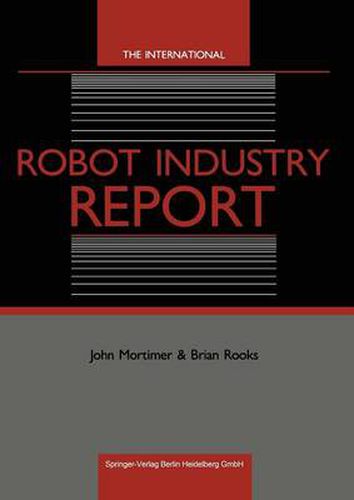Readings Newsletter
Become a Readings Member to make your shopping experience even easier.
Sign in or sign up for free!
You’re not far away from qualifying for FREE standard shipping within Australia
You’ve qualified for FREE standard shipping within Australia
The cart is loading…






This title is printed to order. This book may have been self-published. If so, we cannot guarantee the quality of the content. In the main most books will have gone through the editing process however some may not. We therefore suggest that you be aware of this before ordering this book. If in doubt check either the author or publisher’s details as we are unable to accept any returns unless they are faulty. Please contact us if you have any questions.
Like many other new technologies which have since been seized and exploited by others, the industrial robot is a British invention. In 1957, a patent was produced by a British inventor, Cyril Walter Kenward, and later it became crucial to the future of robotics. For across the Atlantic two robot builders, Unimation and AMF, both infringed this patent and ultimately a cash settlement was made to Kenward. The owner of Unimation Inc. was Joseph Engelberger, an entrepreneur and avid reader of Isaac Asimov, the writer who helped to create the image of the benevolent robot. It is claimed that Engelberger’s journey of fame down the road which led to him being hailed as the ‘father of robotics’ can be traced to the day that he met George C. Devol at a cocktail party. Devol was an inventor with an impressive list of patents to his name in the electronics field. One of Devol’s patent applications referred to a Programmed Transfer Article. Devol’s patent was issued in 1961 as US Patent 2,988,237, and this formed the basis of the Unimate robot which first saw the light of day in 1960. The first Unimate was sold to Ford Motor Company which used it to tend a die-casting machine. It is perhaps ironic that the first robot was used by a company which refused to recognise the machine as a robot, preferring instead to call it a Universal Transfer Device.
$9.00 standard shipping within Australia
FREE standard shipping within Australia for orders over $100.00
Express & International shipping calculated at checkout
This title is printed to order. This book may have been self-published. If so, we cannot guarantee the quality of the content. In the main most books will have gone through the editing process however some may not. We therefore suggest that you be aware of this before ordering this book. If in doubt check either the author or publisher’s details as we are unable to accept any returns unless they are faulty. Please contact us if you have any questions.
Like many other new technologies which have since been seized and exploited by others, the industrial robot is a British invention. In 1957, a patent was produced by a British inventor, Cyril Walter Kenward, and later it became crucial to the future of robotics. For across the Atlantic two robot builders, Unimation and AMF, both infringed this patent and ultimately a cash settlement was made to Kenward. The owner of Unimation Inc. was Joseph Engelberger, an entrepreneur and avid reader of Isaac Asimov, the writer who helped to create the image of the benevolent robot. It is claimed that Engelberger’s journey of fame down the road which led to him being hailed as the ‘father of robotics’ can be traced to the day that he met George C. Devol at a cocktail party. Devol was an inventor with an impressive list of patents to his name in the electronics field. One of Devol’s patent applications referred to a Programmed Transfer Article. Devol’s patent was issued in 1961 as US Patent 2,988,237, and this formed the basis of the Unimate robot which first saw the light of day in 1960. The first Unimate was sold to Ford Motor Company which used it to tend a die-casting machine. It is perhaps ironic that the first robot was used by a company which refused to recognise the machine as a robot, preferring instead to call it a Universal Transfer Device.